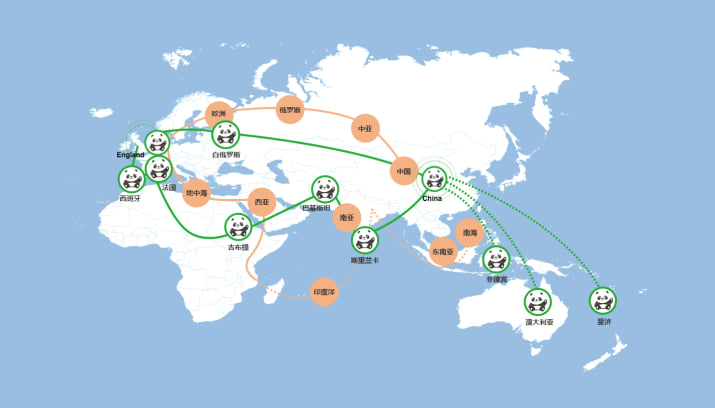You read that correctly: Hong Kong-headquartered company Panda Green Energy are bringing Panda Solar Farms to the world.
They’re doing so with the backing of the Chinese Government as well as the UNDP (United Nations Development Programme). The UNDP works across about 170 countries, promoting sustainable development, democratic governance and resilience to climate change and disasters. This is a serious mandate, but construction of solar farms fits the brief. Why make them shaped liked pandas?
First question: Why?!
According to the South China Morning Post (SCMP), the idea behind Panda Solar Farms came from 17-year-old Ada Li Yan-tung. A Hong Kong native, who attended high-school in the US , Li was looking for a way to make other teenagers more aware of renewable energy and its role in the fight against climate change.
“I love pandas so much, so I was thinking, why not have pandas, because it is a symbol of both China and peace,” she told SCMP.
“Putting that with the solar panels might transform the mundane shape of the bulky panels into a more fun figure, so it will attract more teenagers and global attention.”
In 2015, Li attended a sustainability forum in Paris as a youth representative, which the UNDP co-hosted. Li pitched her idea to delegates, among them former US vice-president Al Gore, who she describes as her idol.
“I was really excited to see Mr Al Gore,” Li said. “When I was seven or eight, my dad showed me a documentary, An Inconvenient Truth … It sort of planted the seed in me.”
From little things, big things grow.
Panda Green Energy picked up Li’s idea and it has blossomed into a project of epic proportions. The company now hopes to bring Panda Solar Farms to the globe, including down under.

Panda Green energy are planning to rollout 100 farms across 60 countries. The majority of these will be along China’s Belt and Road Initiative (BRI) trade route. The BRI is a development strategy of the Chinese government, intended to connect, and facilitate trade between Eurasian countries. The BRI, AKA the “new Silk Road”, connects much of Europe, Asia, the Middle East and Africa into a China-centric trading network.
According to Panda Green Energy’s chief executive, the total investment in Panda Solar Farms will be around US$3 billion.
Datong (in China) is home to the world’s first panda solar farm, which came online in June 2017. It currently boasts a 50-megawatts peak production capacity. However, it’s not finished yet, and will eventually output 100-megawatts. This output is expected to be enough to power about 10,000 homes annually. In doing so, the farm should reduce carbon emission by some 2.74 million tonnes over 25 years.
How do they get the panda-shape?
We thought you’d ask! The black and grey parts of the panda are your typical mono-crystalline silicon PV panels. (PV stands for Photovoltaics, which refers to the conversion of sunlight into electricity thanks to the photovoltaic effect.)
Mono-crystalline silicon PV systems are commonplace in Australia. Think your average residential rooftop solar. They consist of solar panels, made up of numerous solar cells. The cells are dark black in colour, with rounded corners, which look like they’re “missing”. This is a result of the production process, as well as the physical nature of mono-crystalline silicon.
The white parts of the panda are thin-film solar cells.
If PV solar is first generation technology, thin-film solar cells are second generation. Thin-film cells are created by depositing one (or more) layers of photovoltaic material on a substrate — typically glass. Although, plastic and metal substrates can also be used.
The benefits of thin-film technology of traditional PV solar panels are that it’s lighter, more flexible, and semi-transparent. This transparency means photovoltaic glazing material can be laminated onto windows of commercial buildings. …and also makes it perfect for the white parts of a panda. But perhaps above all, it’s cheaper to produce.
All these upsides come at the cost of thin-film PV being less efficient than first generation solar PV, with a shorter lifespan. Which probably explains why thin-film PV accounts for less than 10% of worldwide photovoltaic installations.

The importance of Panda Solar Farms.
You got us. The above sentence should simply have read, “The importance of solar farms”. We could have dropped the “panda”, but SEO.
The importance of solar PV technology can’t be understated. This hit home last week when we researched our article paying homage to Australia’s Professor Martin Green, who won the Global Energy Prize 2018. Since then, we’ve exchanged a further email with Professor Green, who thinks global solar installations should reach over 100 GW this year, and 1 terawatt by 2024, with China leading the way in terms of deployment. (In fact, China say they have already beat their 2020 goals for renewable energy deployment.)
If Professor Green’s predications are correct, “This would reduce CO2 emissions by circa 1.5Gt/y”. And this is a figure that would make a real difference in terms of slowing down climate change.
In a world driven by publicity and popular opinion, we also like Ada Li Yan-tung’s take on all this. She says it’s all about awareness, “My goal is to spread and raise awareness of this topic – that’s what I wanted,”
“The world really does belong to us, to the future generations. Climate change is an urgent thing that we have to solve.”
“It feels more urgent in China,” she said. “We don’t have a second chance. We have only one earth.”







